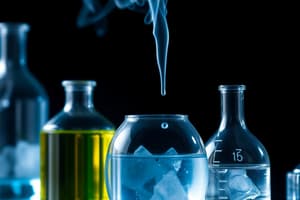Podcast
Questions and Answers
What type of reaction is combustion, in terms of energy?
What type of reaction is combustion, in terms of energy?
- Exothermic (correct)
- Dependent on the surroundings
- Neither exothermic nor endothermic
- Endothermic
During a neutralization reaction, what happens to the temperature of the surroundings?
During a neutralization reaction, what happens to the temperature of the surroundings?
- It increases (correct)
- It remains the same
- It decreases
- It depends on the acid and base used
Which of the following is an example of an endothermic physical change?
Which of the following is an example of an endothermic physical change?
- Melting (correct)
- Freezing
- Deposition
- Condensation
What is the site where the reactants react in an acid-base reaction?
What is the site where the reactants react in an acid-base reaction?
During an exothermic reaction, what happens to the kinetic energy of the molecules in the surroundings?
During an exothermic reaction, what happens to the kinetic energy of the molecules in the surroundings?
What happens to the temperature of your hands when using hand sanitizer?
What happens to the temperature of your hands when using hand sanitizer?
What type of reaction is thermal decomposition, in terms of energy?
What type of reaction is thermal decomposition, in terms of energy?
What is the role of water in an acid-base reaction?
What is the role of water in an acid-base reaction?
What type of reaction is photosynthesis, in terms of energy?
What type of reaction is photosynthesis, in terms of energy?
What happens to the energy of the surroundings during an endothermic reaction?
What happens to the energy of the surroundings during an endothermic reaction?
Flashcards are hidden until you start studying
Study Notes
Exothermic and Endothermic Reactions
- Exothermic reactions release energy to the surroundings.
- Endothermic reactions absorb energy from the surroundings.
Exothermic Reactions
- Chemical changes:
- Combustion: CH4(g) + O2(g) → CO2(g) + 2H2O(g)
- Neutralization: NaOH(aq) + HCl(aq) → NaCl(aq) + H2O(l)
- Physical changes:
- Freezing: H2O(l) → H2O(s)
- Condensation: H2O(g) → H2O(l)
- Deposition: H2O(g) → H2O(s)
Endothermic Reactions
- Chemical changes:
- Photosynthesis: 6CO2(g) + 6H2O(l) → C6H12O6(s) + O2(g)
- Thermal decomposition: CaCO3(s) → CaO(s) + CO2(g)
- Physical changes:
- Melting: H2O(s) → H2O(l)
- Evaporation/boiling: H2O(l) → H2O(g)
- Sublimation: H2O(s) → H2O(g)
Reaction Systems and Surroundings
- In chemical reactions, the temperature measured is often that of the surroundings.
- The system consists of the reactants, while the surroundings include the solvent and everything around the reaction site.
Energy Transfer
- In exothermic reactions, energy is released as heat, increasing the kinetic energy of the surrounding molecules and the temperature.
- In endothermic reactions, energy is absorbed from the surroundings, decreasing the kinetic energy of the surrounding molecules and the temperature.
- Chemical potential energy is the energy stored in chemical bonds.
- Exothermic reactions release energy, resulting in lower potential energy in the products.
- Endothermic reactions absorb energy, resulting in lower potential energy in the reactants.
Studying That Suits You
Use AI to generate personalized quizzes and flashcards to suit your learning preferences.




